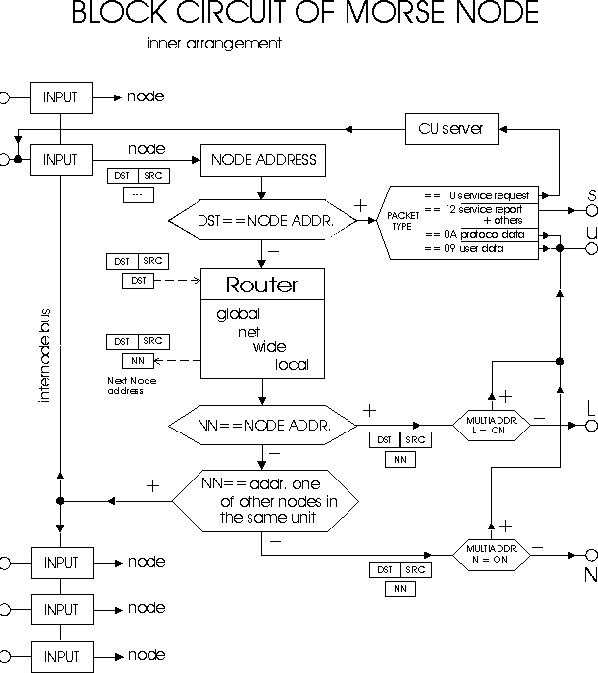Simplified description
Packet incoming to the node, contains it’s target address DST. The address of immediate next step NN is determined in the node according to address DST.
The address DST is compared with address of the node (NODE ADDRESS), where the process runs. If they are equal then the packet is in the target node and will be sent, according to its type, to the user or service port or to the service processing. If they are different, then the routing tables processing follows.
The packet address can be divided to the 4 parts called (from left) global, net, wide and local. The “global” part represents a big unit where the address belongs (country), part “net” determines more exactly the region inside the country (geographically or according to other points of view). Next specifying is in part “wide” and part “local” defines finally the actual address of node. At the choice of routing table the addresses DST and NODE ADDR are compared. The parts global, net, wide and local are compared gradually. If the difference is found (for example in “net” part), then in the respective table (net) will be the address of next step found. The differences in lower parts (here wide and local) are then not important.
The routing table contains the pairs (p)ath and
(n)ode. The (p)ath represents the compared part
of the address (here net) and (n)ode is address of node NN
where leads the next step of packet on it’s way to DST address. The tables
wide and local contains in (n)ode the lower address part
only. The item (n)ode is the resultant information found in
the routing tables and is inserted into address NN.
The packet equipped now by the NN address goes to the next processing according to diagram Block circuit of MORSE node. If the NN address equals to NODE ADDR, then the packet is sent to the link output L.
In next step is the address NN compared with addresses of other nodes in own CU. If the concordance is found, then the packet is sent through inner bus to the respective node.
If the packet is no diverted to the link output or inner bus, then it is sent to the net retranslation output N. The address NN becomes then the next step adrress TO in the MORSE network.
In this way the packet is sent to the net medium (most frequently radio channel) and for it’s next processing takes charge this node, which address is equal to TO address contained in the packet.
The more detailed description is in chapter Routing 2. The particular routing examples follows in the next chapter.
